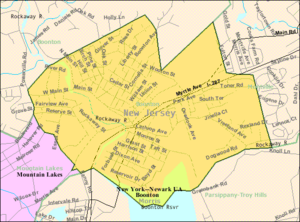Boonton Gorge facts for kids
The Boonton Gorge is a cool river gorge located in Boonton, New Jersey. Here, the Rockaway River flows over several waterfalls and travels for a bit more than a mile. It eventually empties into the Jersey City Reservoir.
Contents
How the Gorge Was Formed
The Rockaway River starts its journey through flat areas like Denville and Boonton Township. At this point, it's about 480 feet (146 meters) above sea level.
The Boonton Gorge begins where the Rockaway River spills over a 6-foot (1.8-meter) tall man-made dam in Boonton. This spot is called Grace Lord Park. It's also where the river starts its drop over the Ramapo Fault.
A Look at Ancient Earth
The Boonton Gorge was formed a very long time ago, during the late Triassic Period. This was when the North American continent started to pull away from Africa.
Imagine the Earth's crust cracking! A big crack, called the Ramapo Fault, formed. The land between this fault and another one near Paterson sank down. This sinking land created the gorge we see today.
The River's Journey Through the Gorge
The river first flows over rocks, then plunges down a 30-foot (9.1-meter) waterfall. It lands in an oval-shaped pool with a rock in the middle. This pool is about 50 yards (46 meters) long. It used to be a popular swimming spot until 1990.
Next, the river drops over a smaller 7-foot (2.1-meter) waterfall. It then flows under an old, arched stone bridge, known as the arch bridge. The water moves quickly here!
The river then enters a second pool, which is narrower than the first. The water slows down a bit before picking up speed again. It rushes through iron ore rock, passing several pointed rocks.
After going under a railroad bridge, the river slows down for about 100 yards (91 meters). Then it drops over a 3-foot (0.9-meter) concrete structure called a USGS gauging station weir. Soon after, it flows under Route 287.
The river then follows the east side of Route 287. In just a quarter of a mile (0.4 km), it drops 40 feet (12 meters)! Finally, it empties into the Jersey City Reservoir, flowing through a "boulder garden" of large rocks.
Before the Reservoir
Before the Jersey City Reservoir was built, the Rockaway River's rapids would have continued for another half-mile (0.8 km). They would have stopped near Parsippany.
In total, before the dam was built, the river dropped 260 feet (79 meters) over a mile and a half (2.4 km).
Indian Rock
Near the arch bridge, there's a huge boulder about 15 feet (4.6 meters) high. People locally call it "Indian Rock." In the past, it was also known as "Washington Rock." You can even see a large metal ring at the top of this boulder!
Exploring the Gorge: Hiking Trails
The Boonton Gorge has a small but well-kept system of trails. These trails are great for fishing or just enjoying nature. They offer awesome views of the river and its waterfalls.
The trails on both sides of the river are connected by the old stone arch bridge, which was built in the 1800s. Along the trails, you'll find historical markers. These markers show remains of the local iron industry that used to operate here in the 19th century.
You'll also find special yellow "Riverphones" near the waterfalls. These phones are for calling emergency help if someone has an accident. Boy Scouts installed them in 1997, and the Boonton Fire Department now manages them.
Fishing and Canoeing Adventures
Fishing in the Gorge
The New Jersey Fish and Game department stocks the river with Rainbow and Brown trout several times each spring. They usually do this on Mondays from early April to late May.
Fishing here can be a challenge because the water is swift and there are many places for fishing lines to get snagged. But even with the challenges, the fishing is usually very good!
Whitewater Canoeing and Kayaking
Even though local officials have recently tried to discourage kayaking and canoeing in the Boonton Gorge, it's still a popular spot for whitewater paddling. There are no local laws or state laws that forbid these activities.
This section of the river is known as a Class IV-V whitewater run. This means it's pretty challenging! Paddlers usually start above the stone arch bridge. They then paddle down to the gauging station or the edge of the Jersey City Reservoir.
The river drops about 120 feet (37 meters) for every mile here. You can paddle the river when the water gauge reads from 2.7 feet (0.82 meters) up to 5 feet (1.5 meters).
- At 2.7-3.2 feet (0.82-0.98 meters), the river is shallow and rocky. It's rated Class 3+ on the International Scale of River Difficulty.
- From 3.2 to 4 feet (0.98-1.2 meters), it's rated Class 4.
- From 4 to 5 feet (1.2-1.5 meters), it's rated Class 5.
When the gauge reads 5 feet (1.5 meters), the river is considered to be flooding. At this level, it's flowing at 2,000 cubic feet (57 cubic meters) per second! Only very experienced paddlers should try this section at higher water levels.


